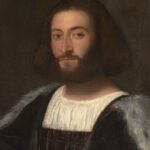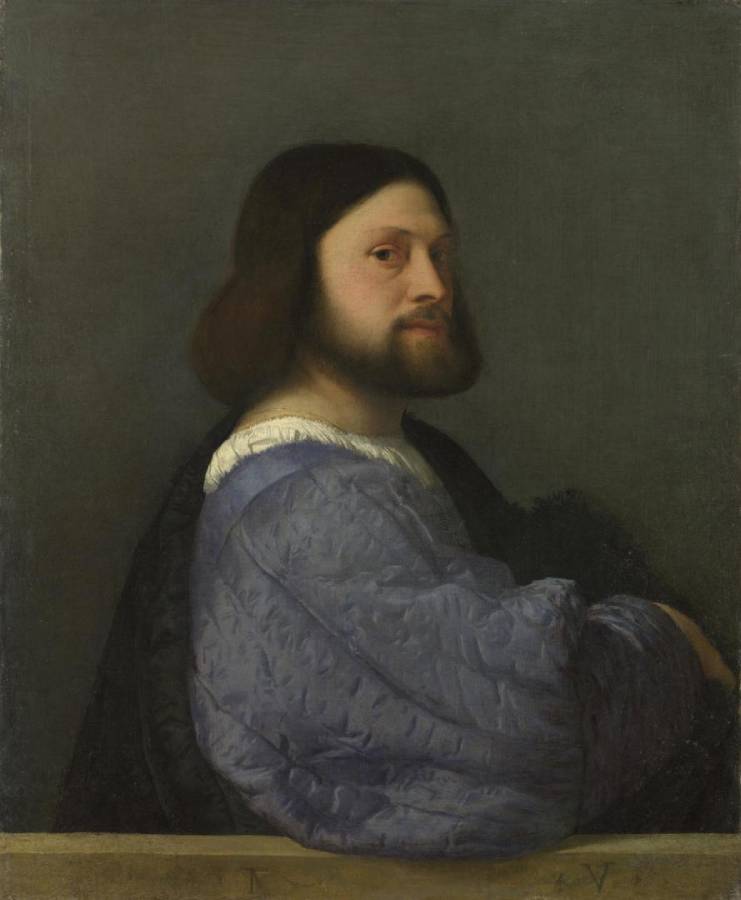Tiziano (c.1488-1576)
Ludovico Ariosto (or Gerolamo (?) Barbarigo)
c.1510
Oil on canvas, 81.2 x 66.3 cm
National Gallery, London
Titian painted portraits more frequently than any other type of picture and he painted them throughout his long career. This is one of his earliest. It retains the sense of inner mystery expressed in the portraiture of his teacher Giorgione but expresses the sitter’s personality with new strength and realism. Titian has captured his subject in a highly innovative, dynamic pose – turning to look at us over his shoulder and momentarily meeting our gaze.
The ‘turning’ portrait, depicting the sitter looking over his or her shoulder, had been popular in Venice since about 1500, for example in the Portrait of Francesco Maria della Rovere, possibly painted by Giorgione and certainly associated with him (Kunsthistorisches Museum, Vienna). It was also common in early Renaissance Italian portraits to use an imaginary parapet to resolve the problem of how to crop a figure not portrayed at full length. This device further served to divide the sitter’s space from that of the viewer. But unlike in most earlier portraits featuring a parapet, the sitter here is cut at waist rather than bust level, emphasising the volume of the torso and arms and creating a new sense of monumentality and space.
The man’s elbow rests on the parapet and his voluminous quilted sleeve projects into our space, creating a strong sense of his physical presence. The blue of the quilted satin sleeve was painted over a pink ground and fine red lines are threaded through it. It must originally have been more purple in tone but the red lake pigment has faded over time, while surface abrasion has somewhat reduced its sense of volume. The sitter’s right hand appears to be in a fur muff, although this is now difficult to make out. The merging of the shadowed portions of the figure with the grey atmospheric background was, however, certainly intended, and is one of the most innovative and influential aspects of the portrait.
The man’s body forms a stable triangle in the centre of the canvas. The solidity and balance of the composition means that the decisive turn and tilt of his head produces a dramatic effect. Our attention is focused on the raised brow above his right eye, which is positioned midway across the picture. This novel and effective pose was to become highly influential in European portraiture, serving as a model for such famous pictures as Rembrandt’s Self Portrait at the Age of 34 of 1640, Van Dyck’s Self-Portrait of about 1640 (National Portrait Gallery, London) and Reynolds’s Self-Portrait of 1775 (Uffizi, Florence). The pose may have been popular, but it was uncomfortable. The diarist Samuel Pepys records sitting for Van Dyck: ‘I sit to have it full of shadows and do almost break my neck looking over my shoulders to make the posture for him to work by.’
This was long believed to be a portrait of the celebrated Italian poet Ludovico Ariosto (1474–1533), and it was later thought to be a self portrait by Titian – possibly why so many artists chose to portray themselves in this pose. However, it is likely to be a portrait described by Giorgio Vasari in his 1568 biography of Titian. Noting that the artist was no more than 18 years old, Vasari identifies the sitter as a member of the aristocratic Venetian Barbarigo family. The most likely candidate is Gerolamo di Andrea Barbarigo, who was the grandson of Doge Marco Barbarigo. In 1509 Gerolamo was elected as one of the magistrates responsible for navigation, a position for which one had to be at least 30 years old. He belonged to Venetian humanist circles and enjoyed a political and diplomatic career in Venice and its mainland territories.
Vasari records that through Barbarigo’s intervention, Titian was commissioned to paint in fresco certain scenes on the Fondaco dei Tedeschi (German merchants‘ warehouse) in Venice, for which his older colleague Giorgione had painted the principal facade. The sitter in a contemporary portrait at Alnwick Castle, probably not by Titian but close to his style, closely resembles the one in Titian’s portrait, but has brown rather than blue eyes. He may be another member of the Barbarigo family, possibly a brother to the National Gallery sitter.
It is hard to assess the accuracy of Vasari’s statement as to Titian’s age when he painted the portrait. It is certainly possible that he was no more than 18, although he could have been slightly older than that. We know that Giorgione completed work on his frescoes for the Fondaco dei Tedeschi in December 1508 and that Titian began his afterwards, suggesting that the younger artist worked there in the summer of 1509. A later statement by the Venetian author Lodovico Dolce that Titian worked on the Fondaco dei Tedeschi when he was not more than 20 is generally considered to be reliable.
It is notable that Titian’s Portrait of Gerolamo (?) Barbarigo and Sebastiano’s Salome of 1510 employ the same arrangement. It is impossible to say which picture was painted first, but the fact that Titian’s is more commandingly three-dimensional would suggest that he was upstaging his friend Sebastiano’s picture, rather than the other way round. It is unlikely, however, that they are far separated in date – both artists were close associates of Giorgione, who pioneered the ’turning portrait‘, and they responded rapidly to each other’s innovations at the time. Another related picture is Christ carrying the Cross in Scuola Grande di San Rocco of around 1508–9. Thought to have been painted by Giorgione or Titian, its figure of Christ resembles closely the man with the quilted sleeve, and may have been based on the same model or acted as a formal prototype for the National Gallery portrait.
As in Portrait of a Lady (’La Schiavona‘) Titian has inscribed his own initials ’T. V.‘ (Tiziano Vecellio) on the parapet. Infrared reflectography reveals another V in the centre of the parapet, which has been painted out. The mysterious abbreviation VV once also appeared on ‘La Schiavona’ and on other Venetian portraits of this date, such as Giorgione’s Giustiniani Portrait. It may stand for virtus vincit (‘virtue is victorious’), vivens vivo (‘from life by the living’) or virtù e verità (‘virtue and truth’). (NG)
Compare:
 Tiziano (c.1488-1576)
Tiziano (c.1488-1576)
Ludovico Ariosto (?)
c.1508–1510
Indianapolis Museum of Art, Indianapolis
See also:
• Ariosto, Ludovico (1474-1533)
